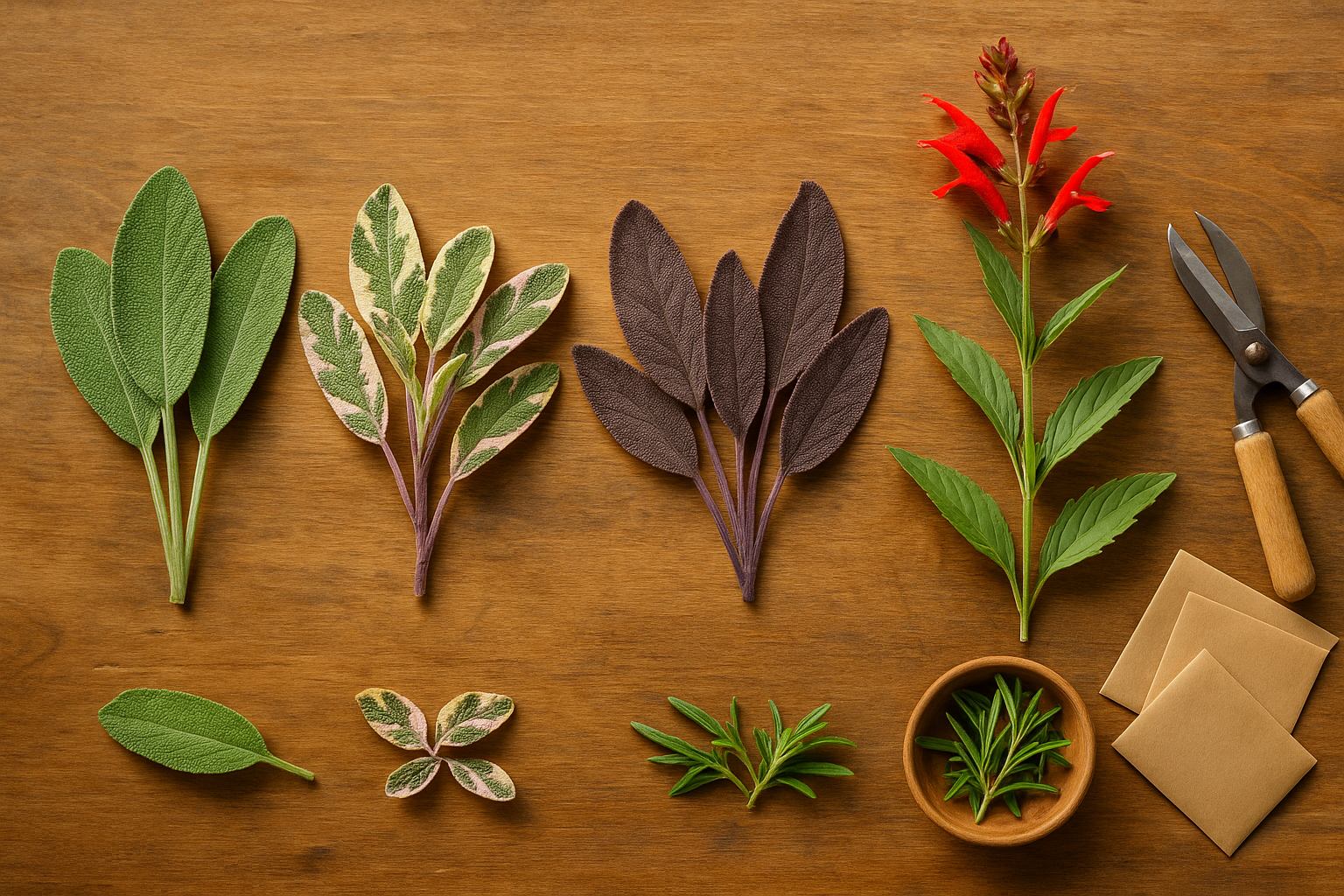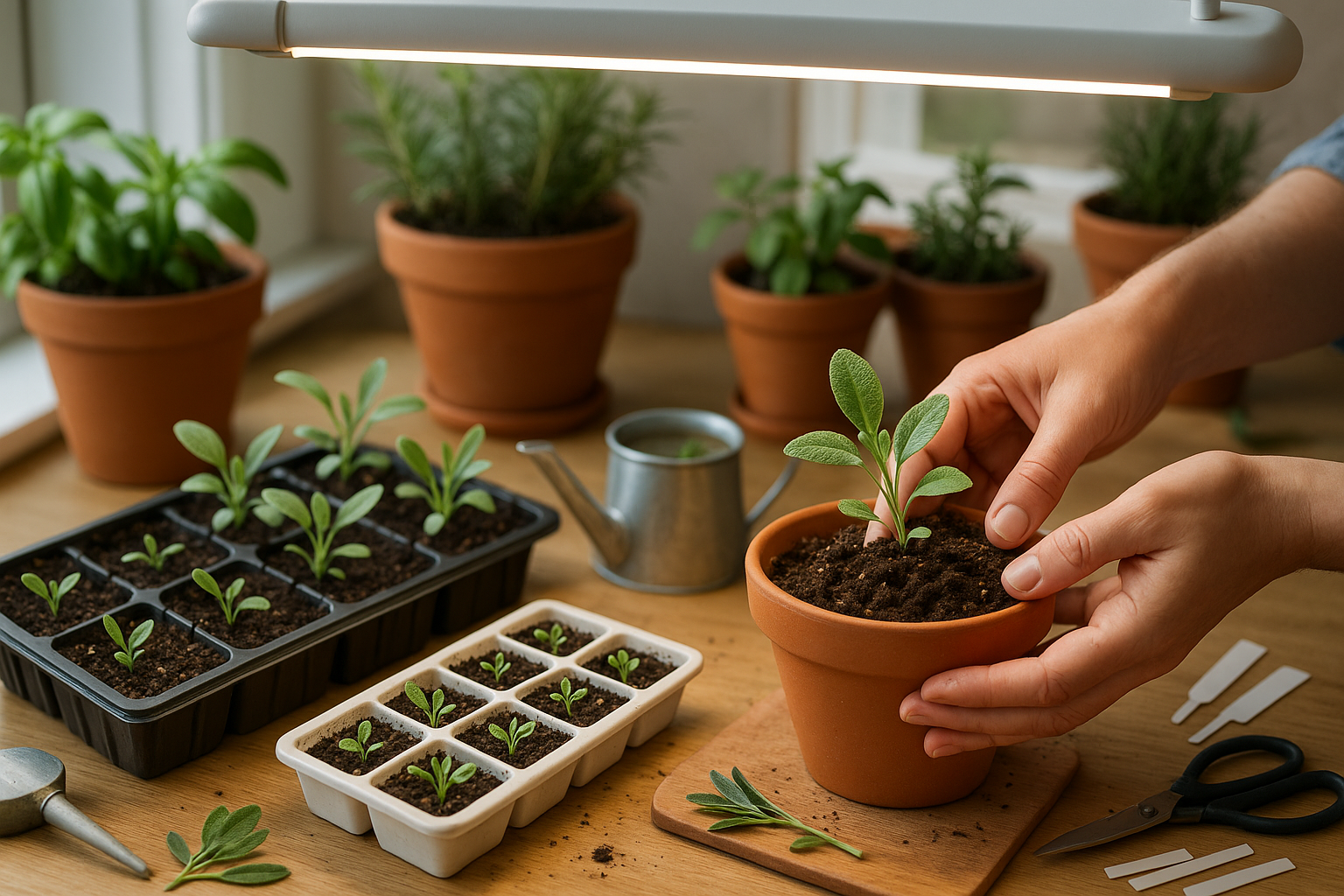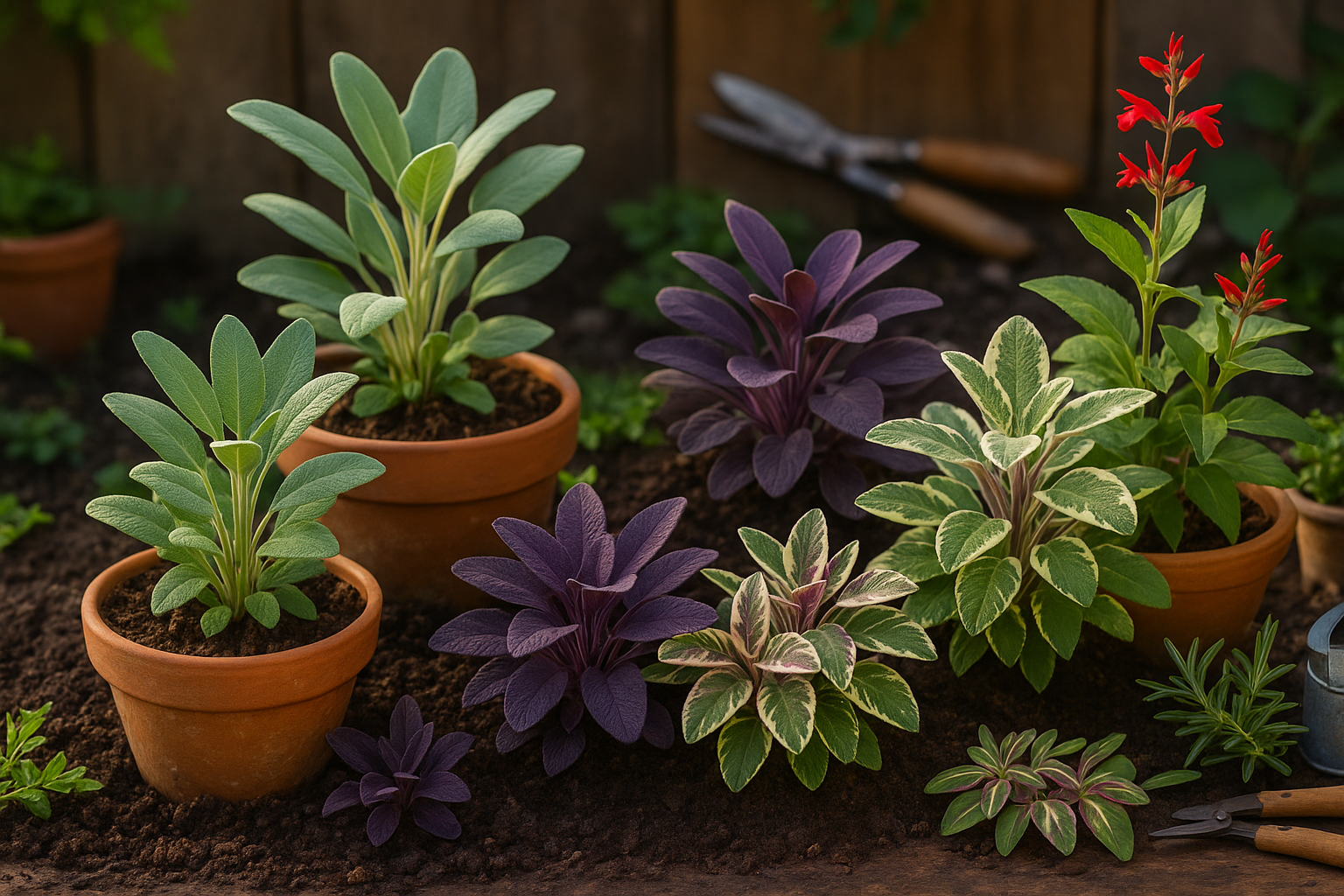Choosing the Right Sage Variety

When it comes to choosing the right sage variety for your home or garden, it helps to know that not all sages are created equal. Common or garden sage (Salvia officinalis) stands out as a classic culinary favorite—its robust, earthy flavor makes it the go-to choice for roasting meats, seasoning stuffing, and more.
If you’re after something visually striking, purple sage offers deep violet foliage that provides a beautiful pop of color in flower beds or mixed containers, and it’s also edible. Tricolor sage, with its variegated green, white, and purple leaves, adds ornamental flair to window boxes, hanging baskets, or patio pots. While flavorful, its texture is sometimes less tender than common sage for recipes.
Pineapple sage, known for its sweet, fruity scent and brilliant red flowers, is less often used for savory cooking, but its leaves work well in teas or fruit salads. Plus, it’s a pollinator magnet for garden beds.
For container growing or indoor herb gardens, common and tricolor sages are often the best picks thanks to their compact size and tolerance of occasional neglect. Outdoor gardeners in cooler climates may prefer common sage for its hardiness, while pineapple sage thrives in warmer areas and can even grow as a perennial in frost-free zones. If you’re short on indoor space, look for dwarf varieties or keep plants pruned for bushiness.
No matter which sage you choose, be mindful of your local climate and available space—there’s a variety to fit nearly every situation.
Planting Sage Indoors and Outdoors

Starting sage can be done in several ways, making it an accessible herb for both new and seasoned gardeners. If you’d like to grow sage from seeds, sow them indoors about 6-8 weeks before the last expected frost in your area, as seeds can be slow to germinate—sometimes taking up to three weeks. Use a well-draining seed-starting mix and lightly cover the seeds, keeping the soil moist but not soggy.
Alternatively, you can propagate sage from cuttings by snipping a healthy 4-inch stem, removing the lower leaves, and placing it in water or moist soil until roots develop—usually in a few weeks. For a head start, nursery plants or starter plugs offer the quickest route to a thriving sage patch.
Outdoors, transplant seedlings or plants after all danger of frost has passed and daytime temperatures stay above 60°F (16°C). Indoors, you can start any time of year, but ensure your spot receives at least six hours of direct sunlight daily; a south-facing window or supplemental grow light works best.
Sage thrives in sandy, well-drained soil with a neutral to slightly alkaline pH (6.5–7.0). For indoor planting, choose containers with good drainage holes and use a high-quality potting mix amended with a bit of sand or perlite to encourage drainage.
When transplanting outdoors, space sage plants about 18 to 24 inches apart to allow good air circulation, which helps prevent disease. After transplanting, water deeply but allow the soil to dry between waterings—sage dislikes sitting in wet roots.
With the right start and a little attention, you’ll enjoy fresh sage leaves year-round, perfect for seasoning your favorite dishes or brewing into calming teas.
Caring for Sage Through the Seasons
Keeping your sage plant healthy year-round involves a few simple but important care routines. Water your sage moderately—let the soil dry out a bit between waterings to avoid root rot, especially in winter when growth slows.
During the growing season, feed sage every 4-6 weeks with a balanced, diluted fertilizer; in fall and winter, cut back on feeding as the plant naturally rests.
Pruning is key: in early spring, trim back woody stems to encourage bushier new growth. Throughout the summer, pinch off flower buds to keep the plant focused on leaf production.
Sage thrives in a wide temperature range but prefers mild conditions. If you live where winters drop below freezing, bring potted plants indoors before the first frost. Inside, try to maintain moderate humidity—too much can encourage mildew, while too little can dry out the leaves. A pebble tray under the pot or occasional gentle misting can help if your home’s air is dry, but avoid waterlogged conditions.
Mulching with straw or shredded bark around outdoor sage plants insulates roots from temperature swings and helps retain moisture. During heatwaves or cold snaps, temporarily shade your plant or move containers to a more sheltered spot to reduce stress.
If you grow sage indoors, rotate the pot weekly to ensure even sunlight exposure, preventing the plant from growing lopsided or developing weak, leggy stems.
With these routines, your sage will not only survive but thrive no matter the season, providing you with lush, fragrant leaves for kitchen use all year long.
Overwintering and Troubleshooting Sage
Protecting your sage plants during the winter is essential for keeping them healthy all year round, especially if you live in an area with freezing temperatures. For sage grown directly in the ground, apply a thick layer of mulch—such as straw, shredded leaves, or pine needles—around the base of the plant to insulate the roots and retain moisture.
If your sage is in pots, consider moving the containers indoors to a sunny windowsill or a cool, sheltered spot like an unheated garage where temperatures stay above freezing. If moving pots isn’t an option, cluster them together and wrap them in burlap or frost cloth for added protection.
Winter can also bring pest and disease challenges despite the cold. Aphids and spider mites may take shelter on sage during mild spells, while fungal diseases like powdery mildew can appear if the foliage stays wet. Combat pests by rinsing the leaves with a gentle spray of water or applying insecticidal soap as needed. Prevent mildew by ensuring good air circulation and removing any affected leaves promptly.
If your sage starts looking leggy, woody, or lackluster—especially after winter—don’t worry. Trim back the stems by a third in early spring to encourage new, bushier growth and improve airflow. Feed the plant with a balanced, slow-release fertilizer or compost as the weather warms, and always cut back any dead or damaged stems.
By giving your sage these seasonal boosts and keeping an eye out for common issues, you’ll enjoy vigorous, flavorful herbs year after year.
Harvesting and Using Sage All Year
Sage thrives when pruned regularly, so the best time to harvest its leaves is in the morning after the dew evaporates but before the midday sun. Pick mature leaves, leaving plenty of new growth to keep the plant healthy—snip with clean scissors to avoid damaging the stems.
For year-round use, preserve your bounty by air-drying bunches in a cool, dark place or using a dehydrator for faster results. Once crispy, crumble the leaves and store them in airtight jars away from light. Alternatively, freeze whole leaves flat on a tray, then transfer them to freezer bags—this keeps their flavor surprisingly vibrant.
Love convenience? Mix chopped sage with olive oil, pour it into ice cube trays, and freeze. This gives you instant portions for future dishes.
Sage’s use isn’t just for poultry and stuffing. Blend dried sage with honey for a soothing sore throat tea, or infuse it in warm water for a calming foot soak. Deep-fried sage leaves make a crunchy, aromatic garnish for soups and salads, while a few fresh sprigs in roasted vegetables or compound butter can elevate weeknight meals.
With thoughtful harvesting and simple preservation methods, sage becomes a versatile staple you’ll reach for in your kitchen and home remedies all year long.
Summary and FAQs
Growing sage year-round is easier than you might think. A few simple steps ensure you have healthy, fragrant plants at your fingertips. Start by planting sage in well-drained soil with plenty of sunlight—whether in a garden bed or a sunny windowsill pot. Water sparingly, allowing the soil to dry out between drinks, and feed with an all-purpose fertilizer every few months.
Pruning is best done every few months, especially after flowering, which encourages bushier growth and prevents your sage from becoming leggy. Many people ask if sage grows well indoors—absolutely! With at least six hours of sunlight or a grow light, your kitchen can host thriving sage all year long.
As for lifespan, sage is a hardy perennial: with good care, it can easily live three to five years or even longer. Don’t be afraid to experiment—try different varieties or companion plants to see what works best for your space. Remember, even if you’re new to gardening, sage is forgiving and rewarding. Mistakes are part of the process, and each harvest will boost both your confidence and your culinary creations. Stick with it, and you’ll enjoy fresh sage whenever you need it.
